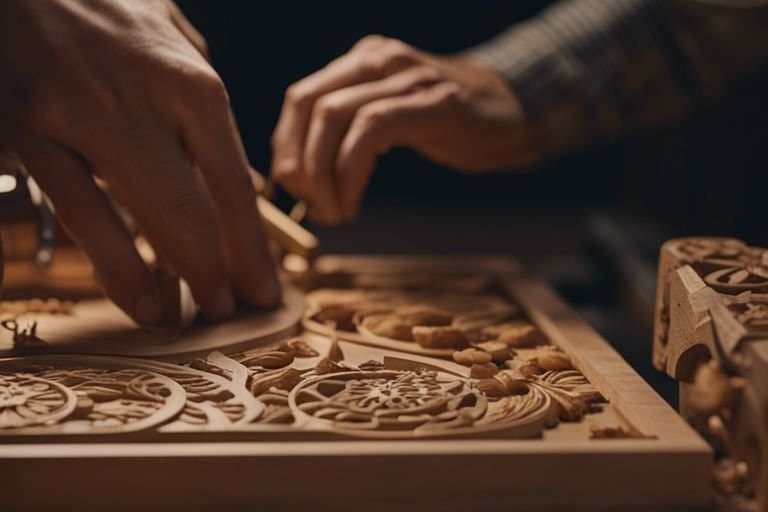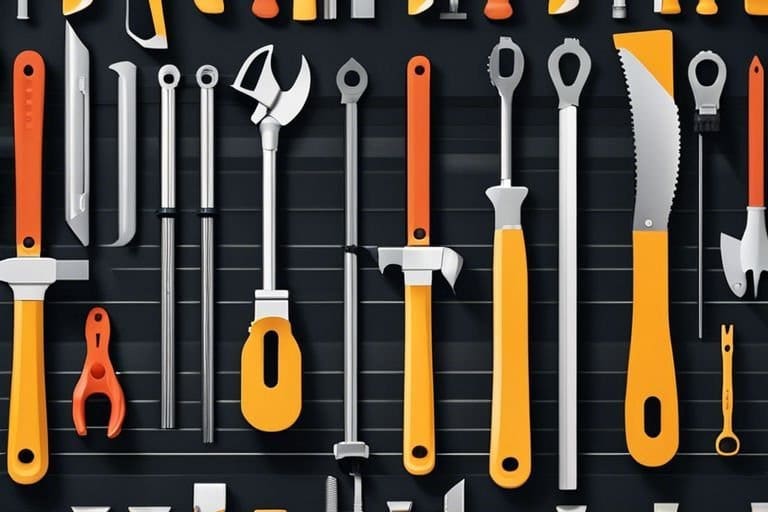You have a passion for woodworking and want to create beautifully intricate designs using hand tools, but safety is always a top priority. In this guide, we will provide you with crucial tips and techniques to ensure you can safely use hand tools to bring your creative visions to life. By following these guidelines, you can confidently navigate through your projects with precision and care, resulting in stunning and safe craftsmanship.
Understanding Hand Tools
Before stepping into crafting intricate designs, it’s crucial to understand the different hand tools available for the job. Hand tools are manual devices that are powered solely by the user’s hands without the use of electricity or any other external power source. These tools are crucial for creating intricate designs as they allow for more control, precision, and attention to detail.
Types of Hand Tools for Crafting Intricate Designs
Now, let’s explore the various types of hand tools that are commonly used for crafting intricate designs. These tools come in a wide range of shapes and sizes, each serving a specific purpose to help artisans bring their artistic visions to life. Recognizing the right tool for the job is vital for achieving professional results. Importantly, here is a breakdown of some crucial hand tools for crafting intricate designs:
| Tool | Function |
|---|---|
| X-Acto Knife | Precision cutting and carving |
| Chisels | Wood carving and sculpting |
| Needle-nose Pliers | Detail work and gripping |
| Scalpel | Fine cutting and delicate work |
| Embossing Stylus | Embossing and creating textures |
Factors to Consider When Choosing the Right Hand Tool
Consider the following factors when selecting the right hand tool for your crafting needs. These considerations will help you choose the most suitable tool for the task at hand. Thoroughly evaluating these factors will ensure a smooth crafting process and impeccable results. Thou shall keep in mind the following when selecting hand tools:
- Material you will be working with
- Complexity of the design
- Comfort and ergonomics of the tool
- Budget constraints
- Quality and durability of the tool
For instance, when working with soft materials such as clay or foam, you may opt for tools with finer tips for intricate detailing. On the other hand, if you’re sculpting hardwood or metal, you’ll need more robust tools that can withstand the tougher materials. Ultimately, choosing the right hand tool is crucial for bringing your creative ideas to life with precision and finesse.
Preparing for Safe Hand Tool Use
Essential Safety Equipment for Hand Tool Users
One of the most crucial aspects of preparing for safe hand tool use is ensuring you have the necessary safety equipment. This includes items such as protective goggles to shield your eyes from flying debris, gloves to protect your hands from cuts and abrasions, and ear protection if you will be working with loud tools.
Creating a Safe Workspace for Crafting
With hand tools, it’s important to have a designated and organized workspace that is free from clutter. Ensure your work area is well-lit so you can see clearly, and that you have enough space to maneuver your tools safely. Keep your workspace clean and tidy to prevent tripping hazards and to make it easier to locate your tools when needed.
For instance, if you are working with sharp hand tools like chisels or carving knives, make sure to keep them properly stored when not in use. This will help prevent accidental cuts and injuries. Additionally, consider using a sturdy workbench or table to provide a stable surface for your crafting projects.
Tips for Maintaining Good Posture and Reducing Fatigue
- Safe tool use starts with good posture. Make sure to stand or sit up straight while working to reduce strain on your back and neck.
- Take frequent breaks to stretch and rest your muscles, especially if you are working on intricate designs that require fine motor skills.
Recognizing when you are starting to feel fatigued and taking a break can prevent accidents and ensure you can continue crafting safely.
It’s important
- to adjust your workspace to suit your body mechanics. Position your tools and materials at a comfortable height and distance to prevent unnecessary strain on your muscles.
Mastering Basic Hand Tool Techniques
How to Properly Hold and Grip Hand Tools
There’s a fundamental skill that every craftsman should master when it comes to working with hand tools – how to properly hold and grip them. Whether you’re using a chisel, a hand saw, or a carving knife, the way you hold and grip the tool can significantly impact the outcome of your work. Make sure to choose a grip that feels comfortable and allows you to have control over the tool’s movements.
Basic Cutting, Shaping, and Smoothing Techniques
Clearly, mastering basic cutting, shaping, and smoothing techniques is crucial for any woodworking or crafting project. Understanding how to make precise cuts, create intricate shapes, and achieve smooth finishes will elevate the quality of your work. Practice using different hand tools to cut, shape, and smooth various materials until you feel confident in your abilities.
It’s crucial to pay close attention to the angle and pressure applied when cutting, shaping, or smoothing materials. Using the right technique can make a significant difference in the final result of your project.
Tips for Achieving Precision and Control
It’s crucial to remember that achieving precision and control while using hand tools requires practice and patience. Start by selecting the right tool for the job and ensuring it is sharp and in good condition. Before making any cuts or shaping any material, take a moment to plan out your approach and visualize the desired outcome.
- Keep your workspace well-lit and organized to avoid any accidental mishaps.
- Always wear appropriate safety gear, such as goggles and gloves, to protect yourself while working with hand tools.
The key to achieving precision and control lies in your ability to focus on each movement and make deliberate actions with your hand tools. By practicing regularly and paying attention to detail, you’ll soon develop the skills needed to create intricate designs with ease.
- The quality of your craftsmanship will improve as you continue to hone your skills and refine your techniques.
With dedication and practice, you’ll soon be able to master the art of using hand tools to craft intricate designs with precision and finesse.
Advanced Hand Tool Techniques for Intricate Designs
Many artisans and craftsmen looking to create intricate designs often turn to advanced hand tool techniques to achieve their desired results. These techniques require precision, patience, and a steady hand to master. Below are some of the advanced techniques that can help you take your crafting to the next level:
- How to Use Hand Tools for Carving and Engraving
- Tips for Creating Intricate Patterns and Designs
- Factors to Consider When Working with Delicate Materials
How to Use Hand Tools for Carving and Engraving
Carving and engraving are vital skills for creating intricate designs on various materials. To achieve precision and depth in your carvings, start by selecting the right tools for the job. Sharp chisels, gouges, and knives are vital for detailed work. Practice making controlled cuts and gradually increase the complexity of your designs as you gain confidence.
When engraving on surfaces like metal or wood, use a light touch and let the tool do the work. Experiment with different techniques to create texture and depth in your designs. Remember to always work in a well-lit area and take breaks to avoid hand fatigue.
Tips for Creating Intricate Patterns and Designs
With intricate designs, planning and patience are key. Before starting a project, sketch out your design on paper to visualize the final product. Use rulers, compasses, and stencils to create precise lines and shapes. Consider incorporating negative space into your design to add complexity and visual interest.
- Practice on scrap material before working on your final piece.
- Experiment with different techniques to find what works best for you.
Any mistakes or imperfections can be incorporated into the design or used as learning opportunities for future projects.
Factors to Consider When Working with Delicate Materials
Working with delicate materials like thin wood veneers or fragile fabrics requires special attention to detail and finesse. Before starting a project, assess the fragility of the material and adjust your techniques accordingly. Use sharp, high-quality tools to minimize tearing or distortion of the material.
- Choose the right tools for the material you are working with.
- Avoid applying too much pressure when cutting or shaping delicate materials.
The key to success when working with delicate materials is to proceed slowly and carefully, ensuring that each step is executed with precision.
Common Mistakes to Avoid When Using Hand Tools
Once again, it is crucial to emphasize the importance of using hand tools safely to avoid unnecessary risks and injuries. Here are some common mistakes that you should be aware of and strive to avoid when working with hand tools:
How to Identify and Prevent Common Injuries
Assuming that accidents won’t happen can lead to overlooking safety precautions. It is crucial to be proactive in identifying potential hazards and taking the necessary steps to prevent injuries while using hand tools. Some common injuries to be mindful of include cuts, bruises, and strains from misuse or mishandling of tools.
Tips for Troubleshooting Common Hand Tool Problems
Any craftsman will encounter issues with hand tools at some point. To troubleshoot common problems effectively, consider the following tips:
- Ensure the tools are properly maintained
- Use the correct tool for the job
- Inspect tools regularly for wear and tear
Assume that addressing these common problems promptly can help prevent accidents and ensure the longevity of your hand tools.
Factors to Consider When Working with Power Tools
Identifying the key factors to consider when working with power tools can significantly impact your safety and the quality of your work. Some important factors to keep in mind include:
- Understanding the power tool’s capabilities and limitations
- Using appropriate safety gear
- Being mindful of your surroundings and potential hazards
Even experienced craftsmen should continuously review and reinforce these factors to ensure safe and efficient use of power tools. This proactive approach can prevent costly mistakes and injuries in the workshop.
Caring for Your Hand Tools
How to Clean and Maintain Hand Tools
After a productive crafting session, it’s crucial to properly clean and maintain your hand tools to ensure they remain in top condition. The key to keeping your tools in prime shape is to wipe them clean with a damp cloth to remove any excess dirt or debris. For stubborn grime, use a mild soap solution and a brush to scrub the tools gently. Once clean, remember to dry them thoroughly to prevent rusting.
Tips for Storing and Organizing Hand Tools
The proper storage and organization of your hand tools can help increase their longevity and your crafting efficiency. Invest in a sturdy toolbox or chest to keep your tools protected and easily accessible. Consider using dividers or foam inserts to prevent tools from banging against each other and causing damage. Additionally, labeling drawers or sections can save you time by quickly locating the right tool for the job.
- Store tools in a dry location away from moisture to prevent rust.
- Hang larger tools such as hammers or screwdrivers on pegboards for easy access.
Clean, well-organized tools not only last longer but also make your crafting projects more enjoyable and efficient. By following these simple storage and organization tips, you can spend less time searching for tools and more time creating beautiful designs.
Factors to Consider When Replacing or Upgrading Hand Tools
When the time comes to replace or upgrade your hand tools, there are several factors to take into consideration to make the best decision for your crafting needs. Perceiving the quality, durability, and ergonomics of a tool is important in determining its value and longevity.
- Consider the frequency of use and the type of materials you work with to ensure the new tool can handle your projects.
Upgrading your hand tools can enhance your crafting experience and make intricate designs easier to achieve. By investing in high-quality tools that suit your needs, you can elevate your craftsmanship to new levels.
Conclusion
On the whole, using hand tools to craft intricate designs can be a fulfilling and rewarding experience, but it is imperative to prioritize safety at all times. By following proper safety precautions such as wearing protective gear, maintaining a clean workspace, and using tools correctly, you can minimize the risk of accidents and injuries. Additionally, it is crucial to regularly inspect your tools for any damage and to ensure they are well-maintained for optimal performance.
Remember that crafting with hand tools requires patience, practice, and attention to detail. Take your time to learn how to use each tool properly before stepping into complex projects, and don’t hesitate to seek guidance or training if needed. By prioritizing safety and following best practices, you can enjoy the process of crafting intricate designs while preserving your well-being.




